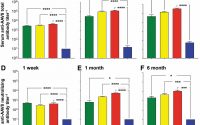In Romania, distrust of vaccines kills
Measles still claims young lives in Romania, where nearly 40 children have died in an outbreak that many blame on parents being misled by scare stories that vaccinating them is dangerous.
Some 12,000 people have contracted measles since late 2016 in the European Union’s second-poorest country, 46 of them died.
Among the dead, 39 were children under the age of three who had not been vaccinated, making Romania one of the worst affected countries in the ongoing measles outbreak in Europe.
“People are mistrustful because they read all sorts of things on the internet,” said Dr. Silvana Dan, from the southern regional Prahova Public Health Authority, citing persistent rumours that vaccination causes autism.
A girl aged just 11 months died in the region in March after her parents refused to vaccinate her.
Measles is a highly contagious viral disease that affects children in particular but it has largely been brought under control.
The World Health Organization (WHO) says deaths caused by measles plunged from 550,100 in 2000, to just under 90,000 in 2016.
Paradoxically, and to the horror of health authorities worldwide, this very success has seen the public let down its guard and question whether vaccination is now really necessary.
Local officials say health workers are “on the barricades,” doing all they can to get the message across, especially in rural areas, that measles is a killer which can be stopped.
It is not straightforward.
“The reasons for people not being vaccinated are different in different population groups,” local WHO representative Miljana Grbic told AFP.
“Our research shows that there are specificities such as convenience of services, education, support of family doctors, community support and peer support that play a big role here,” Grbic said.
Roma especially vulnerable
In Valea Seaca, some 250 kilometres (150 miles) northeast of Prahova, another baby girl of just 10 months died of measles in February.
“Her parents refused, in writing, to have their children vaccinated after seeing reports on television that vaccines kill,” local mayor Ioan Pravat told AFP.
The National Centre for the Supervision and Control of Transmissible Diseases says most measles cases are found in more vulnerable, disadvantaged communities, Roma for the most part, who often do not have access to a family doctor or if they do, only ask them for help in an emergency.
The local authorities hope that Roma health workers can help ease that problem.
Aurelia Oprisan, one of them, makes her rounds every day in Boldesti-Scaieni, to the south, knocking on doors to spread the vaccination message.
“Many people are negatively influenced by the press so I tell them that what they are hearing is not true,” Oprisan told AFP.
There are signs this approach may be working.
“I don’t want to lie to you. At the beginning I, too, was afraid because I had heard that there could be problems, like causing paralysis,” said Anisoara Iorga.
“But then I did get my children vaccinated and they had no problems at all.”
Progress but below target
If there is progress overall, there is also still a way to go.
The WHO recommends a vaccination rate of 95 percent for effective control. But in Romania, it is 87 percent for the first inoculation and only 75 percent for the second, according to the latest official figures from 2016.
Some critics say the authorities share part of the blame because the supply of vaccine is irregular and insufficient.
Stung into action, the government has pledged to improve vaccination rates by making 10 child vaccines compulsory but debates on a draft law submitted last year have made little progress.
“We have received lots of amendments which we are in the process of analysing,” said Florin Buicu, a doctor and Social Democrat MP who chairs parliament’s health committee.
Many of these have been submitted by anti-vaccine groups who have become increasingly active, Buicu said.
Medical professionals are outraged.
Source: Read Full Article


